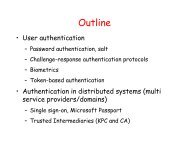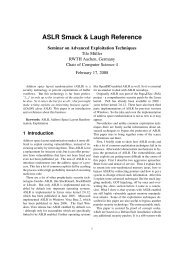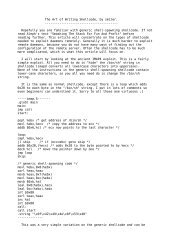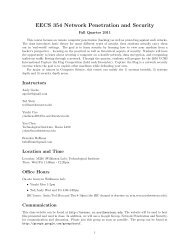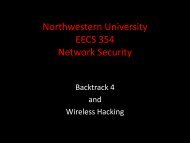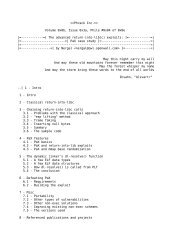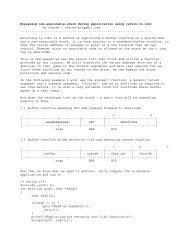Fixing Races for Fun and Profit: How to abuse atime - University of ...
Fixing Races for Fun and Profit: How to abuse atime - University of ...
Fixing Races for Fun and Profit: How to abuse atime - University of ...
Create successful ePaper yourself
Turn your PDF publications into a flip-book with our unique Google optimized e-Paper software.
activemaze<br />
Maze 0<br />
Maze 1<br />
Maze 2<br />
Maze 3<br />
Maze 4<br />
target<br />
relative link<br />
relative link<br />
relative link<br />
public<br />
secret<br />
relative link from exit<br />
relative link from exit<br />
relative link from exit<br />
relative link from exit<br />
relative link from exit<br />
relative link <strong>to</strong> public file<br />
relative link <strong>to</strong> secret file<br />
Figure 9: Malicious direc<strong>to</strong>ry structure <strong>for</strong> attacking the<br />
r<strong>and</strong>omized k-Race defense. The exit links in each<br />
maze point <strong>to</strong> the symbolic link target <strong>and</strong> the attacker<br />
points target <strong>to</strong> the public or protected file depending<br />
on the victim’s current system call.<br />
7 Attack on R<strong>and</strong>omized k-Race<br />
Recall that our attack program gains access <strong>to</strong> the CPU<br />
while the victim is in the middle <strong>of</strong> executing one <strong>of</strong> its<br />
system calls, so it is impossible <strong>for</strong> the adversary <strong>to</strong> predict<br />
the victim’s next system call. Instead, we describe<br />
methods <strong>for</strong> determining the victim’s current system call<br />
<strong>and</strong> reacting appropriately.<br />
Distinguishing access(2) <strong>and</strong> open(2) calls is surprisingly<br />
easy on most Unix operating systems. In Solaris 9,<br />
any process can read the current system call number <strong>of</strong><br />
any other process from /proc/pid/psinfo. Linux<br />
<strong>and</strong> FreeBSD do not export the system call numbers <strong>of</strong><br />
processes, but we can exploit a side effect <strong>of</strong> their implementations<br />
<strong>of</strong> the access(2) system call. Recall that access(2)<br />
enables a setuid-root process <strong>to</strong> determine if the<br />
invoking user can access a certain file. When a setuidroot<br />
process runs, the invoking user’s ID is s<strong>to</strong>red in the<br />
processes real user ID, <strong>and</strong> its effective user ID is set <strong>to</strong><br />
0, giving it root privileges. FreeBSD implements the access(2)<br />
system call by copying the process’s real user ID<br />
<strong>to</strong> its effective user ID, resolving the given filename <strong>and</strong><br />
per<strong>for</strong>ming permission checks using the effective user<br />
ID, <strong>and</strong> then res<strong>to</strong>ring the effective user ID <strong>to</strong> its original<br />
value. Every process’s real <strong>and</strong> effective user IDs can be<br />
read from /proc/pid/status on FreeBSD, so an at-<br />
<strong>for</strong> i = 1 <strong>to</strong> 2k + 1<br />
save <strong>atime</strong>(activemaze/sentry)<br />
while <strong>atime</strong>(activemaze/sentry) unchanged<br />
sleep<br />
distinguish victim’s current system call<br />
<strong>to</strong>ggle target symlink between secret <strong>and</strong><br />
public <strong>to</strong> match victim’s system call<br />
link activemaze <strong>to</strong> mazei<br />
Figure 10: Attacker’s algorithm <strong>to</strong> defeat the k-<br />
Race scheme after setting up the direc<strong>to</strong>ry structure<br />
depicted in Figure 9. The victim opens the file<br />
activemaze/sentry/lnk/lnk/.../lnk.<br />
tacker can determine whether the victim is currently calling<br />
access(2) or open(2) by simply checking the victim’s<br />
user IDs: if the victim’s effective <strong>and</strong> real user IDs are<br />
equal, then it is calling access(2), otherwise it is calling<br />
open(2). Linux implements access(2) in a similar way,<br />
but Linux has a notion <strong>of</strong> a process “filesystem user ID”<br />
(fsuid) that is used in all filesystem-related permission<br />
checks. The Linux access(2) system call copies the process’s<br />
real user ID <strong>to</strong> its filesystem user ID instead <strong>of</strong> its<br />
effective user ID, but the attacker can still use the same<br />
idea. She simply checks whether the victim’s filesystem<br />
ID is equal <strong>to</strong> its real user ID. We have tested these access(2)/open(2)<br />
distinguishers on Solaris 9, Linux 2.6,<br />
<strong>and</strong> FreeBSD, <strong>and</strong> they all work. Based on our reading<br />
<strong>of</strong> OpenBSD’s source code, its access(2) implementation<br />
behaves just like FreeBSD’s, so this attack should work<br />
on OpenBSD, as well.<br />
Once the adversary has determined which system call<br />
the victim is executing, she must change the symbolic<br />
links in the maze <strong>to</strong> ensure the victim’s system call succeeds.<br />
Toggling activemaze will not work because,<br />
by the time the attacker gets <strong>to</strong> run, the victim has already<br />
resolved that symbolic link. The attacker needs <strong>to</strong><br />
switch a symbolic link that the victim has not processed<br />
yet. To support this operation, we set up the mazes as<br />
shown in Figure 9, <strong>and</strong> the attacker <strong>to</strong>ggles the symbolic<br />
link, target, between the public <strong>and</strong> protected<br />
files based on the victim’s current system call. Figure 10<br />
shows the attacker’s new algorithm. When the victim<br />
makes a system call, it is <strong>for</strong>ced <strong>to</strong> sleep on I/O while resolving<br />
the filename. The attacker then wakes up, determines<br />
the victim’s current system call, switches target<br />
so the victim’s system call will succeed, <strong>and</strong> advances<br />
activemaze <strong>to</strong> point <strong>to</strong> the next maze. When the victim<br />
resumes, it finishes resolving the filename using the<br />
new value <strong>for</strong> target, so the system call succeeds.<br />
We tested this attack on Linux, Solaris, <strong>and</strong> FreeBSD.<br />
Table 3 shows our results. Against the r<strong>and</strong>omized k-<br />
Race algorithm using k = 100 our attack won at least




